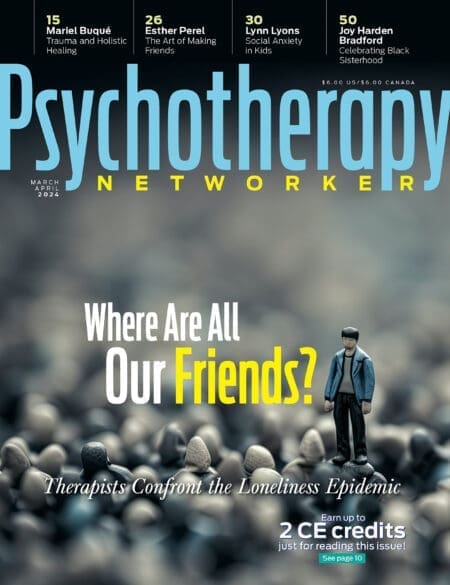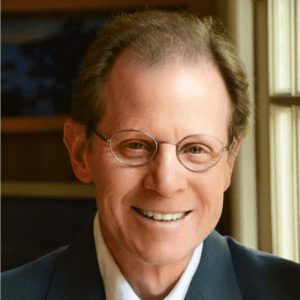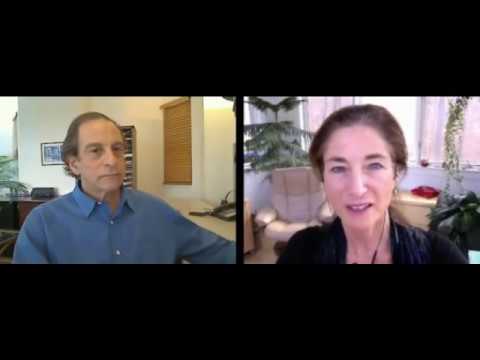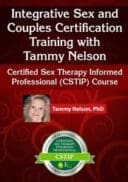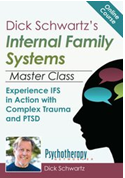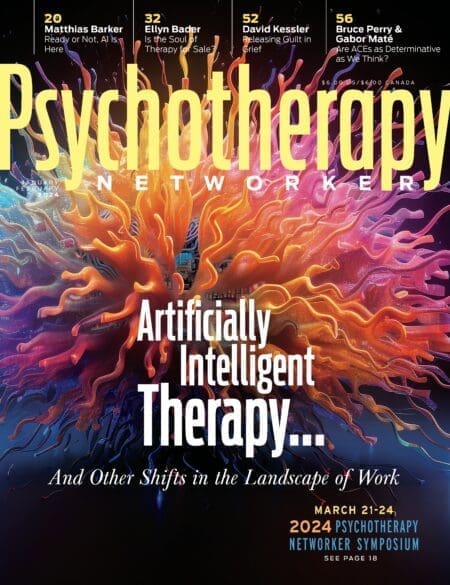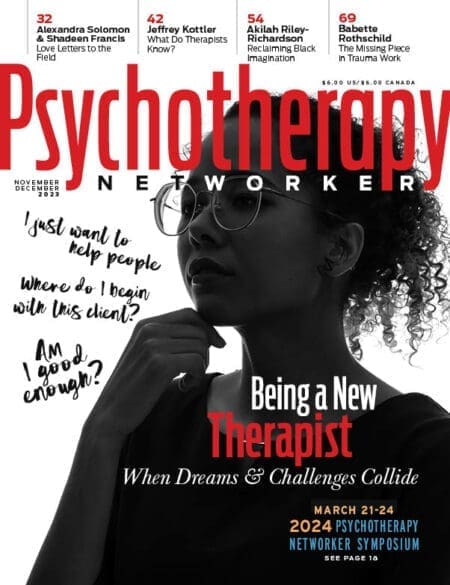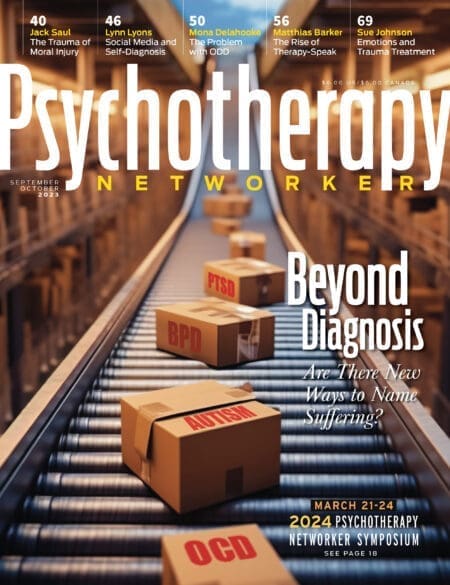This article first appeared in the November/December 2006 issue.
I’m flying from Los Angeles to Boston for a week-long meditation retreat, and I’m feeling nervous. For the next seven days, I’ll be sitting in silence with 100 other scientists at the Insight Meditation Society in Barre, Massachusetts, at an event sponsored by the Mind and Life Institute, an organization devoted to the scientific study of mindfulness and compassion. The event is unique: when before have 100 scientists, most of whom specialize in studying the brain, gathered together to sit in silence for a week and learn “mindfulness meditation”?
I know that teaching mindful awareness to people can markedly improve their physical and mental well-being. At the UCLA Mindful Awareness Research Center, we recently conducted an eight-week pilot study that demonstrated that teaching meditation to people, including adults and adolescents with genetically loaded conditions like attention-deficit/hyperactivity disorder, could markedly reduce their level of distraction and impulsivity.
Still, I have no background in meditation, my mind is always busily running on at least 10 cylinders, and I’ve never been known for my taciturnity.
I told a friend about the silence coming up and he said that talking with other people is his “life’s blood,” and that connecting with others—the talk, the eye contact, the closeness—was what gave his life meaning. Me, too, I said. How will it be to sit completely still for long periods of time, not communicating either verbally or nonverbally (part of the deal) with anybody else for seven days? Why am I doing this? I wonder if it’s too late to back out of the whole thing.
Scientists in Silence
There wasn’t much for me to do in preparation except pack up warm clothes and shoes for this occasion to be in New England in the dead of winter. I was advised the best thing I could do to get ready was to tie up all the loose strings at home and work so that in the silence of the retreat, I wouldn’t feel the urge to call, e-mail, or write anybody back in my ordinary world. As a psychiatrist interested in the brain and relationships, I can’t help wondering what will take over the language-processing areas of my left hemisphere when they, presumably, become silent during meditation? Words are digital packets of information that convey to ourselves and others our models of conceptual reality—how we see and think about the world. They’re part of the brain’s top-down apparatus for ordering and making sense of incoming sensory information.
But then I think of poetry—a different use of language, which inhibits the strictly hierarchical, top-down, left-brain processes organizing our raw experience into a preconceived grid. Poetry, like silence, creates a new balance of memory and moment. We see with fresh eyes through the poet’s artistry, which illuminates with words a new landscape that before was hidden beneath the veil of everyday language. Our ordinary language can be a prison, locking us in the jail of our own redundancies, dulling our senses, clouding our focus. By presenting ambiguities, by using words in unfamiliar ways, by juxtaposing elements of perceptual reality in new combinations, by evoking imagery, poets and their poetry offer us fresh, novel possibilities for experiencing life.
Perhaps the silence of this week will do the same for me.
Day One
I arrive at the Insight Meditation Society, where we’ll be spending the week together. After a brief dinner, tour, assignments of daily cleaning duties, and an introductory talk, we’ve already begun the silence. The idea is to immerse ourselves in the subjective reality of our own minds. With some direction from the insight-meditation faculty here, we’re to dive deeply into the waters of our own internal sea. The form of mindfulness we’ll be learning this week comes from the 2,500-year-old Buddhist practice of Vipassana meditation, which is often translated as “clear seeing.”
On the first day, we learn to sit in the meditation hall with the brief instructions to merely “watch our breathing.” This capacity to focus attention is the first step of mindful-awareness training. When we notice our attention has wandered away from the breath, the instructions tell us, we’re to gently return our focus of attention to the breath. That’s it. Over and over again. I feel relieved. How hard can this be?
But by the end of the first day of practicing this concentration aspect of the meditation, my confidence level has definitely plummeted. I thought I had what the instructors call “good attention,” but, in fact, my mind is repeatedly not cooperating with the instructions to “just focus on the breath.” After a few moments, it seems I can barely make it through an entire breath without having my mind pulled toward different thoughts like a dog zigzagging on a walk, drawn this way and that by enticing scents along the path.
Our instructors tell us that this continual wandering is a totally natural part of the mind itself, and suggest we try just to focus on half a breath at a time: the in-breath, then the out-breath. This helps a bit, but my mind still goes strolling off in all directions. This is sometimes called a “proliferation of the mind,” we’re told—the way the thoughts generate more and more conceptual thinking. The “solution” to this dilemma, once we become aware that our minds have been hijacked by stray thoughts, is to calmly return to focusing on our breath, over and over and over—at least a million times, it seems to me, during the 45-minute session of sitting meditation.
After each sitting period, we do walking meditation that lasts from half an hour to an hour. While walking, we’re to focus on the sensations in our feet and lower legs, step by step. When we notice our minds wandering from the sensation of the steps, we’re to bring our focus back to the walking. Same deal: my mind has a mind of its own and goes where it wants to, not where “I” intend for it go.
Our instructions are expanded more as this first full day goes on. We learn that concentration on the breath will enhance the first step of mindfulness, which is to aim and sustain our attention. By learning to keep our attention focused, we can prevent the constant stream of wayward thoughts, the concepts that comprise our mental processes and get in the way of truly experiencing sensations. Sensation is the gateway to direct experience they tell us. When we can “just” see, or smell, or taste, or touch, or hear—our first five senses—then we enter the realm of being in the moment, a distant realm from where I am with all of the clutter in my mind, as I just sit, and walk, and sit, and walk. Getting close to sensation, it seems, is intended to enable us to just experience without the interference of thinking.
This first day has been both odd and stressful. Being in silence and out of direct communication with anyone makes me feel a bit stir-crazy. I’m driven to connect, but we’re “forbidden” from communicating with anyone, with words or gestures, eye contact or facial acknowledgments of connection. This is the rule that precludes us from joining in any way, and I feel some part of my brain is aching to reach out to the many who are here. I’m beginning to talk to myself, not just in my head, but out loud. I’m even telling myself jokes and laughing. Then I say “Shhh!” to myself, remembering the rule about the noble silence: no communication with anyone. But how about with myself?
During the practice I try to remember what I told myself before this began: Make every breath an adventure. Now I say to myself, “Every half breath an adventure.” But I’m saying this with words, and somehow words have become an enemy, those proliferative concepts that keep me from direct sensation. I’m trapped. I feel confused. I’m feeling the sensations directly, I feel, or I think, but I’m also not giving up the conceptual, word-based dialogue in my head—the words that summarize what I’m doing, like taking a walk, eating an apple—instead of just letting me be doing it. I’ve got some narrator in me that just won’t quit. “Go ahead, try to just drink that soy milk: S-O-Y M-I-L-K I read on the carton. The letters jumping into my sight like a long-lost friend. I even have the words active in my mind when sitting and walking in our sessions. This makes me feel I’m not “meditating mindfully.” Maybe I’m just too intellectual and filled with ideas and questions, words and concepts to be doing any of this.
Day Two
Something shifted today. We get up at 5:15 every day and are in sitting meditation by 5:45. At the end of the first 45-minute session, I had the startling feeling that no time had passed at all. I sat down, began watching my half breath, and before I knew it, the bell had sounded for our 6:30 breakfast. I hadn’t fallen asleep, as I was still sitting bolt upright, my head straight, legs still folded beneath me. Then I went for a long, mindful walk in the snow in the forest outside the main building. At one point, I saw this gorgeous vista of a white-blanketed valley framed by the snow-covered limb of a tall pine, icicles dangling down from a nearby boulder. To my surprise, I burst into tears at the vivid sights and smells and cool air on my face, the sound of the wind in the trees and the crunching snow beneath my boots. And then, just as quickly, I heard a thought in my head say, “You’ll die one day and none of this will be here for you.” My exhilaration vanished in an instant, leaving me distraught. I felt defeated and deflated. It was as if an ancient war were being waged, magnified in my isolated head, between thoughts and sensations.
Later, during a brief group meeting, I described this experience to the teacher and wondered if their mindfulness teaching was playing favorites, as if sensations were better than thinking or anything else we might do, perhaps even than talking with each other. Why were sensations being privileged over thoughts? A teacher said that we’d soon learn that anything arising in the mind, from sensations to thoughts, is to be accepted as it comes without judgment. Her instruction was deeply helpful, making me feel there didn’t have to be a war in my head between direct sensation and conceptual thinking anymore. Perhaps I could broker a truce between the two. But I was surprised that such a simple instruction could produce such a huge shift in my experience.
With this new perspective in mind, at dinner, I had a remarkable experience eating an apple. At each of the meals, in fact in all of our activities besides just the formal sitting and walking practice, we’re to be “mindful.” What this means is to be awake and aware of what’s happening as it’s happening. I decided to eat an apple for dessert. Feeling free to think as well as sense, I decided to do a mind experiment of enhancing the experience of eating the apple. I cut a piece and looked at its texture. I felt the skin, the pulp, and the edge where they met. I smelled the aroma and drank in its wafting, expanding scent. I even decided to put the piece of apple to my ear and see how it sounded (yes, I know, ridiculous, but molecules vibrate and that’s exactly what sound is, so why not try?). All I could hear was the sound of others in the room, no whirring atoms shaking my ear drum. When I placed the apple slowly in my mouth, I could hear the crunching, taste the burst of flavor, feel the pieces against my tongue and teeth, and then sense the shift as the mashing pieces got smaller, and then moved down my throat, into my esophagus, and down into my stomach.
Feeling free now to allow conceptual thoughts into the picture, I allowed my mind to expand and play with images and sensations of the apple’s making its way through my digestive system, being absorbed into my body, and becoming an integral part of me. Then I thought about where the apple had come from—the people in the kitchen who (hopefully) washed it, the staff who bought it, the orchard from which it was picked, the tree on which it grew, and the seed from which that tree sprouted. With the freedom to enjoy this imagery, I suddenly felt a sense of wholeness and oneness with everything—the earth, the chain of people, my body.
I floated out of the dining room and wanted to speak to someone, but remembered the silence. A friend had been in the room, but we couldn’t talk. I went outside and gazed at the almost-full moon in a cloud-strewn evening sky. I felt a presence next to me and found my friend had come out also, on his way to the sleeping area, and paused a moment by me in the silence under the stars. In that silence, a million words couldn’t have said what that shared moment in the moonlight felt like.
Day Three
Today I met with another teacher for a one-to-one meeting. I tried to describe the apple experience. I said that I felt as if there were a flowing river creating my awareness, and this meditation practice was enabling me to go up the current to visit the individual streams flowing into that river—one stream of sensation, one of concepts. This image made me feel more at ease with whatever arose in my mind. He answered by telling me that he often felt that he’d “finally gotten it,” only to realize that there was always something new to experience in awareness. He suggested that I might not want to hold on to any fixed idea of “how things are,” but just see what happened.
I felt dismissed and irritated by his response. After this ten-minute meeting, my head was filled with worded-thoughts and the next few sessions were “difficult.” A difficult session feels as if it were going nowhere; as if instead of feeling the spaciousness of a calm and stable mind, I’m simply spacing out. Spacing out instead of “spacing in.” I get lost in thoughts easily and somehow don’t come back to the breath.
But in the end, this teacher was right. It would get quite a bit more complicated and would be forever changing. No matter how illuminating some experiences have been, you can never predict what the next session will feel like. The mind is always in flux, and nothing seems to predict anything. The idea is to give up expectation and let whatever happens, happen.
In our group instructions, we’ve gone from being told to just watch the breath to also being told to notice sounds and feel our bodies. The breath is like an anchor point, a place to start, but noticing sounds gives us a wider expanse. The body scan—sensing each part of our body, one area at a time—enables us to open our awareness intentionally to the predominant sensations in our body. We just drop into awareness of the body or our senses and take in whatever arises.
Day Four
We’re now expanding the field of awareness to move from the concentration on the breath to becoming mindful and receptive to all that arises, including the experience of mindfulness itself. Nothing is excluded. But the receptive mind isn’t a passive mind. There’s a quality of active engagement, not just with the object of attention, but with awareness itself. Yet this active sense isn’t strained—it has a flowing, grounded, and intentional quality to it.
An insight that emerged on a walking session today came into my awareness without words. This insight was that deep in mindfulness, it isn’t possible to get bored. Words portray a concept, a verbal thought that may articulate even a nonverbal idea. But an insight, like this one, feels more like a shift in internal perspective than a conceptual idea.
There’s a strange change today. It feels as if some part of my mind that was aching to connect with others has given up aiming for them and has turned inward toward myself. I feel a surge of awareness of each step, a kind of connection to myself that wasn’t there before. No moment is like any other, even step after step after step. I feel with each step the pressure on the ball of my feet transitioning to the sole and then the heel. And then the shift in weight in my legs as the next foot takes on the pressure of my body. Each step is unique. There’s no place other than here, no moment other than now. I’m filled with excitement. I feel a floating sensation on the walking meditation, each moment inflated with a kind of helium from my mind.
I want to tell someone, so I tell myself.
Day Five
We’ve been working on full mindfulness in experiencing our sensations, feelings, mental activities, and states. One practice is to start with grounding yourself in a focus on the breath and then move into a more open, expanded, and inquiring state of awareness, which feels something like “bring it on.” Whatever comes, will come. We’re told that it helps some people notice a thought or sensation or mental state (without getting sucked into it) to imagine it emerging from a mouse hole in the wall. Others imagine the thought appearing on a video screen that they can turn on or off.
Neither of those worked for me. Instead, my awareness of the present moment emerged in my mind’s eye as a valley. Thoughts and feelings and images would float like clouds into this valley, where I could see them, name them (“thinking” or “feeling” or “imaging”), and just let them float off, out of my valley of the present moment. Sometimes a thought would arise without my awareness that it had come and, in an instant, I’d be “lost in thought.” There’d be no separation between the thought and me. I’d not only be lost in it, I’d be the thought. At those moments, I was no longer in the valley, but had been swept up into the clouds.
When I became aware of my unawareness of my breath, the key wasn’t to get mad or frustrated or feel like a failure, but to just take note of this experience. It also helped to remember what our teachers told us: that no matter how many decades people spend practicing mindful awareness, there’s always the regular “getting lost in thought” experience. This is just how the mind works. But building mindful awareness helps you see a thought as just arising and floating away. The thought loses its power to kidnap you, make you its captive.
We’ve been also working on ancient meditative practices for the cultivation of “loving-kindness.” Loving-kindness is a fundamental part of mindfulness meditation and aspires to imbue us with a positive regard for all living creatures, our selves included, and the world at large. A set of sayings is repeated, beginning with a focus on the self. These are the particular articulations of those sayings taught by Sharon Salzberg: “May I be safe and protected from harm. May I be happy and have a peaceful and joyful heart. May I be healthy and have a body that supports me with energy. May I live with the ease that comes from well-being.” Having an image of your self in mind can deepen these practices. As these statements are made, the mind’s awareness of the body can focus on the heart region, the area just beneath the chest, as one breathes in, and breathes out. Beginning with loving-kindness for ourselves is necessary, because if we can’t feel it for ourselves, how can we feel it for others?
After focusing on the self, we focus on others. We wish safety, happiness, health, and ease first on a benefactor (someone who’s supported us and our development in life), then on a friend, followed by someone about whom we feel neutral. Often an image of that person is useful to have in mind as these wishes are expressed. The next step is harder—wishing these blessings on a “difficult” person in our life, one with whom we may have a challenging relationship. And the next step can be even harder: we’re asked to offer and ask for forgiveness. “I ask you for forgiveness for anything I’ve done or said that’s caused you harm or painful feelings.” Then, with the same words, one forgives this person.
I chose a friend with whom I’ve had a long-standing relationship that had ended with confusion and hostility recently. I pictured his face, saw the troubles that led to our rift, and asked his forgiveness for what had happened between us. It was hard, as he hasn’t been forthcoming in trying to make a reconnection. But the exercise, including forgiving him for what had happened, helped me feel a sense of resolution.
I personally found this deeply moving, but several in the group during evening lectures expressed difficulty forgiving those who’d done them harm. For others, this entire “metta” or loving-kindness practice was uncomfortable, and some even stopped coming when this was the guided-meditation topic of the session. A number of people later would say that they had a hard time forgiving someone who’d wronged them and hadn’t apologized for the transgressions.
Day Six
I’m feeling as if I now have three palpable streams of awareness flowing into my river of consciousness. One is direct sensory experience. These sensations of my body or of my perceptions feel raw and bare. When I walk, I feel the pressure on the heel of my foot, the transition to the ball, the distribution of weight unevenly onto my toes, the movement of my hips as my other leg slowly swings over the center of gravity and my body leans forward, the next heel touching earth, my other foot’s toes releasing and taking flight. I’m not observing this as a perception; I’m sensing it. As it’s happening in real time, I feel there are no words to describe these sensations, no concepts to analyze and cluster them. They just are their sensory fullness—sights and sounds, inner gurglings, tensions, pressures. I also become quite aware of the second stream—the conceptual stream in the idea of walking. I can almost hear the thought—”walking”—in words that aren’t quite audible in my mind. But now there’s also a third stream flowing that I call the “observer”—the sense that I’m watching myself from afar, out of my head, floating in the hall above me or in the trees above the path where I’m walking.
Each stream—sensation, concept, observer—seems to coexist in the valley of the present moment. I note them, even observing the observer. How odd. At some point, I feel as if I’m losing my mind as my sense of reality crumbles, unraveling before my mind’s eye, literally. Or am I actually finding it? I walk on. Step by step, I watch my mind. I feel my steps. I observe my feeling and even feel my observing.
I haven’t had a conversation with anyone besides brief moments with my teachers in almost a week. No interactions, no speech, no reciprocity. I’m surrounded by others, but am far away, yet so close. I’ve been carrying out the assigned job of cleaning our hall’s bathroom each day. I dreaded this routine at first, but somehow have come to enjoy it, to even relish the task. There’s a kind of connection I feel with the mop, scrubbing the toilet, washing the sink. Day by day, I’ve come to expect the same sort of reaction from the cleaning fluids, the sponges, the rags. It feels comforting to know that somewhere in all this there’s some sort of predictability. I scrub, the dirt disappears. Magic. But in the open valley of the present moment, I never know what will arise.
Needing some kind of anchor point during the walk, I think of a mnemonic for the whole thing. I know we’ve been told to say to ourselves, “not now” or “no thank you” to acknowledge an interesting idea and not get swept up in it. But I can’t help myself. Or perhaps I am helping myself. Step by step my shoeless feet are floating over the wooden floor of this walking room. Step by step. I think: Sensation. Okay. Observation. Fine. Concept. Good. Each of these three streams gives me a sense of knowing the present moment, a knowing paradoxically without words, without concepts, without sensations. This knowing is a kind of subterranean stream beneath this valley of the present moment, a formless Knowing : K. How will I ever remember this amazing vision? Then I think, ” S. O. C. K.” So a sock is around the sole of my feet and SOCK is surrounding the soul of mindfulness, step by step, moment by moment.
Earlier I’d described a three-stream awareness in a question-and-answer period and asked if I was losing my mind. When the observer becomes excessively active, I said, it seems to destroy the direct sensory experience, just as the conceptual thoughts used to do. Do I need to get rid of the observer? I asked. No, the teacher responded. The idea is balance. I can live with that. In fact, I can float with that. And, of course, on the following walk, another mnemonic emerges—the ABCDE of mindfulness: A Balance of Concept and Direct Experience. My left hemisphere just won’t quit!
Day Seven
This is the day we “break silence.” They’ve planned a brief, three-hour period of formal discussion, followed by an evening meal full of chatter and social connections, during which we won’t be aware of the taste the food, I imagine, and then a silent evening meditation before going to sleep until tomorrow morning’s final meditation and discussion. We first meet in pairs, and I’m dying to describe my experience. I tell my partner about these mnemonics and he likes the YODA one best: You Observe and Decouple Automaticity. This describes the role of reflection in waking us up into mindful awareness: observation disrupts being on automatic pilot. We laugh about the idea of “Yoda’s Socks.” Mindfulness may involve more than just sensing—-it may include that capacity to be aware of awareness, to observe experience. When we observe, we can disengage the automatic chatter and less obvious filtering that our emotions and habitual schema create as they distance us from direct experience. Observation feels like the key that ironically unlocks the doors for direct sensation: we observe and note our conceptual mind, and free ourselves to enter the valley of the present moment more fully.
As we emerged from silence, a strange phenomenon seemed to occur that I’ve subsequently been informed is common, not just with scientists: there was a frantic sense, a kind of party atmosphere, once we could speak after our lonely, silent sojourn. But when we later returned to silence, I felt surprising relief, and an open, spacious sense of my mind’s coming back to me. I could feel a clearing of my awareness when I knew I wasn’t to speak to anyone. That lack of contact freed my mind to be open again, to connect to itself. There’s some kind of clarity that comes with silence.
Still, that night, when I called home for the first time in a week, I was glad to connect with my wife and children. And yet, even though things were fine at home, my mind couldn’t stop thinking about our conversation, the plans, the tones of voice, things to be done. For the first time all week, I had a hard time falling asleep and awoke several times, just thinking of various things that had evaporated from my awareness during the week. The pull of my regular life made me realize that I hadn’t been aware of how much quieter my mind had become.
I’d been drinking hot tea all week long without a problem. After calling home, moving out of mindfulness and back into the frenzy and hustle and bustle of “civilian” life, I burnt my tongue. I was thinking of something else instead of being aware of the tea as I was drinking it. Without mindfulness, we can get harried, and burnt.
During the brief science discussions about our ideas and experiences on the last night of the week, I couldn’t get my head in gear. What struck me was how utterly conceptual the conversations felt, and I just wasn’t in a frame of mind to reengage in that way. I welcomed the return to silence that last night. On the ride to the airport the next day with two friends, though, I felt we could go into our experience deeply, slowly, without interruption. It felt satisfying to try to put the week into words and share that with one another. I said that it had felt as though some part of my mind that usually connects with others had, by the middle to end of the week, turned its focus onto the only person available: me. As I described my experience, I could feel that they were attuning to me in a way that I’d felt I was attuning to myself during the week. My science mind imagined it was the mirror neurons that enabled us to resonate with one another. That resonance of internal and interpersonal attunement felt deeply gratifying.
Now, many months later, I find myself still riding the current of those four streams of awareness—sensation, observation, concept, and knowing—that seem to create my experience of the present moment. Having had a week of a silent retreat feels, for me, like a gift of getting to know myself in a new way. Even as a therapist and someone who engages in nearly nonstop reflection, being alone with my own mind during that time somehow brought out a new sense of myself that stays with me to this day.
How have I changed? One way is that the stream of direct sensation seems much stronger and less vulnerable to being crowded out of my life by conceptual thoughts, or even by observation. There’s been more than a “truce” created among these distinct ways of knowing now—I feel a new sense of harmony since the retreat. I no longer become locked on any judgment that one way of being is better than another. Each has its own role to play in the spectrum of life.
In my professional world, I’ve found that teaching mindfulness has taken on a new dimension with my patients. There’s a sense of a central “hub” within my mind that’s become more spacious and holds more of the moment of being between us. It’s hard to describe, but perhaps the feeling is best expressed like this: Being is just this. Whatever is here, we—you, me, relatives, friends, our patients, our students—can contain the fullness of the experience and ride the waves of our awareness streams together. That spaciousness can be shared. A wheel of our awareness can become a collective, group experience, filled with awe, and the illusion of our separateness revealed for what it is: a creation of our minds, a neural invention.
Somehow I feel an open access to a core self beneath identity from the week of silence. This core way of being, underneath the clutter of personality, is something we all have. The simplicity of attuning to our breath, to ourselves, perhaps permits us to gain access to a deeper self that’s the common ground that we can share as we bring mindfulness to each other. At that core place, there may be a path toward healing our global community, one mind, one moment at a time, since kindness is to our relationships what breath is to life.
Dan Siegel
Longtime Psychotherapy Networker contributor Daniel J. Siegel, MD, is a graduate of Harvard Medical School and completed his postgraduate medical education at UCLA with training in pediatrics and child, adolescent, and adult psychiatry. He is currently a clinical professor of psychiatry at the UCLA School of Medicine, founding co-director of UCLA’s Mindful Awareness Research Center, founding co-investigator at the UCLA Center for Culture, Brain and Development, and executive director of the Mindsight Institute, an educational center devoted to promoting insight, compassion, and empathy in individuals, families, institutions, and communities. Dr. Siegel’s psychotherapy practice spans thirty years, and he has published extensively for the professional audience. He serves as the Founding Editor for the Norton Professional Series on Interpersonal Neurobiology which includes over 70 textbooks.
